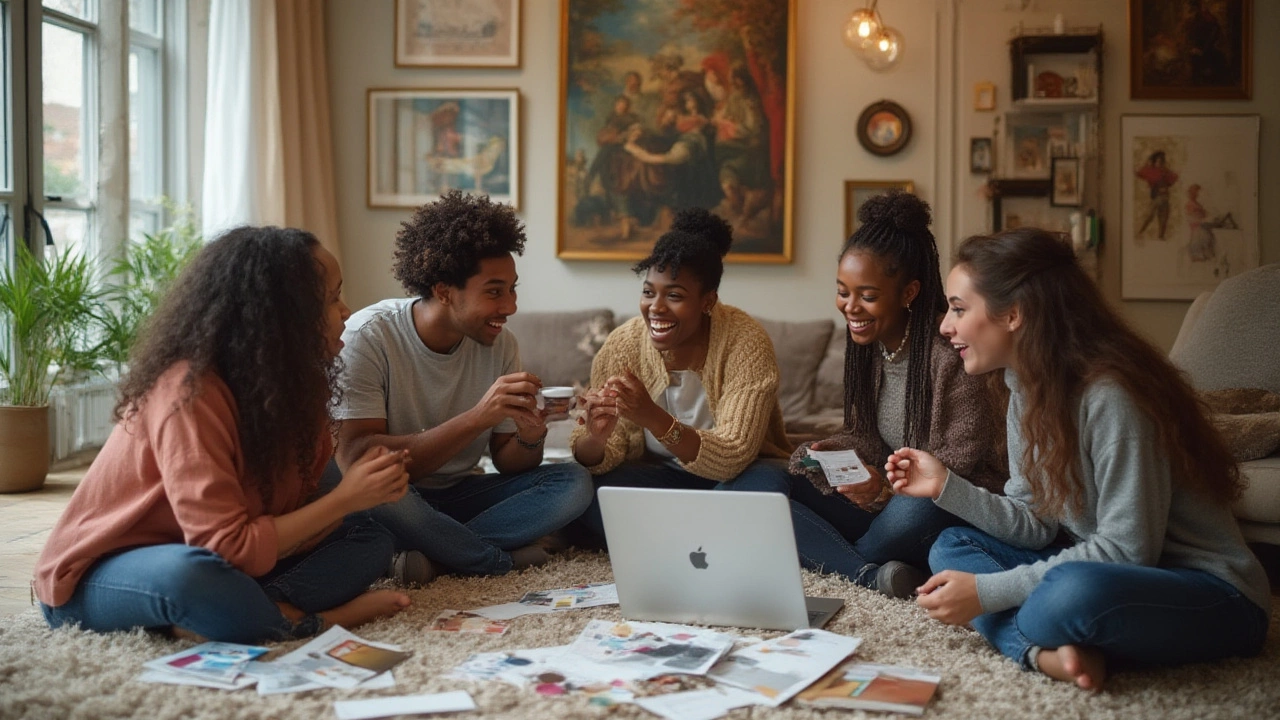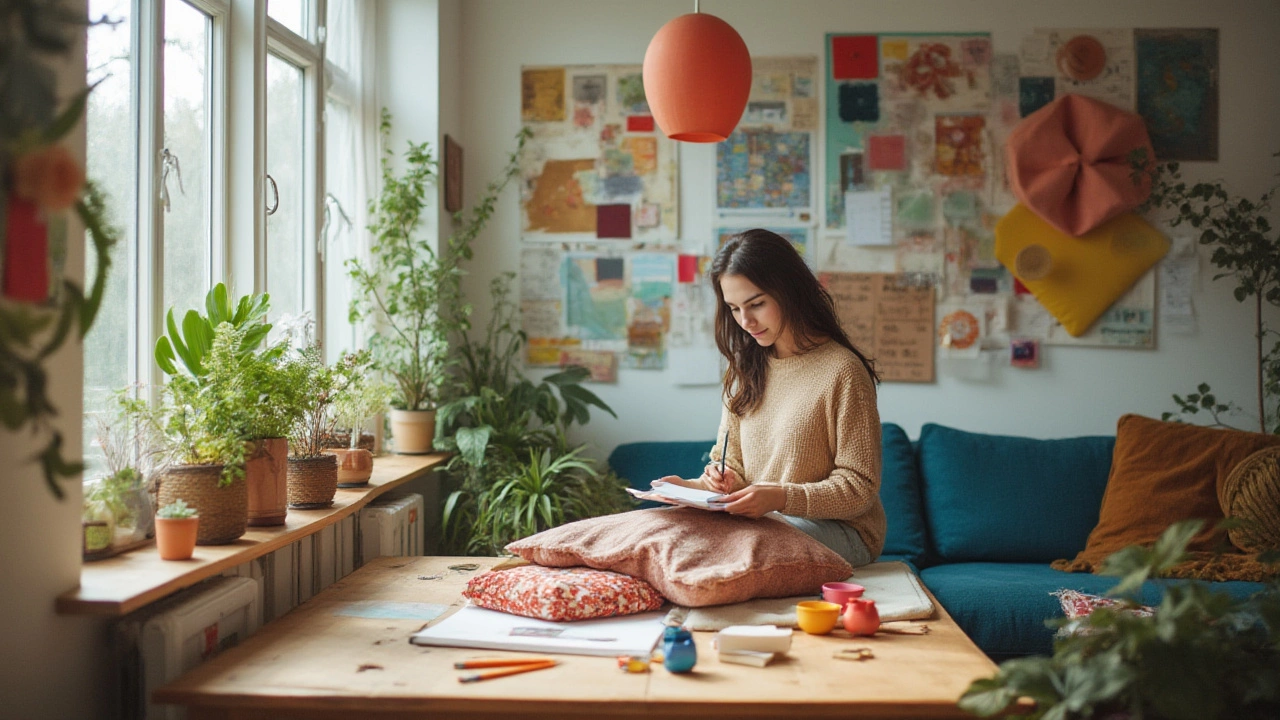Ever walked into a friend’s place and wondered why it just feels so...right? It's not magic. It's interior design, and anyone can learn the ropes. Here's the thing—most people think you need a fancy degree or endless cash to make it work. That’s just not true. Real creativity doesn’t care if it’s your first apartment or a forever home. If your heart skips a beat in a well-styled room, you've got what you need to get started. So, if you’re itching to roll up your sleeves and turn your space into something that makes people stop and stare, you’re in the right place.
Finding Your Style and Inspiration
If you stared at a blank wall and felt lost, you’re not alone. Pinning down your style is the trickiest—yet most exciting—part of interior design. The good news? You don’t have to follow rules written in stone. Some homes mix mid-century chairs with modern lights, and somehow it all works. To get started, begin with what catches your eye. Are you drawn to sleek lines, or do you love the coziness of farmhouse decor? Try flipping through real magazines like Vogue Living Australia or checking Instagram feeds like @thedesignfiles or @homestoloveau—a few binge scrolls can reveal what makes your heart leap.
Create a mood board. No need to get fancy: cut out magazine clippings, print Pinterest images, or use free sites like Canva. Toss in plants, art, color swatches—anything you adore. The goal is to spot patterns and colors you return to again and again. Fun fact: In Australia, earthy tones and indoor greenery are top picks, especially since the pandemic sparked a plant craze in homes across Melbourne.
Don’t skip the power of lighting and layout. Play with natural light on sunny mornings and see how it shifts the vibe. Sometimes, just shifting the sofa makes the place open up. Interior pros experiment with layouts until one “clicks.” Don’t be afraid to try a few combinations—it’s all part of the fun. Even design icons like Patricia Urquiola admit they shuffle furniture for days before settling.
Lastly, get inspired by where you live. Melbourne’s mix of old Victorian terraces and new urban lofts means local design inspiration is everywhere. Visit open homes, design shows (like the DENFAIR event held every year), or peek at the National Gallery of Victoria for color and pattern ideas. Remember, your home is yours—let it say something about you.
Planning and Budgeting Your Project
Here comes the bit you can't skip: planning. It’s tempting to shop first and figure things out later, but trust me, you’ll regret it when your new rug looks lost in the living room. Start by measuring your space—even if you’ve never held a tape measure before. Accurate room dimensions are your secret weapon. If you need a cheat sheet, here are standard sizes used in most Melbourne homes:
| Room | Typical Size (square metres) |
|---|---|
| Living Room | 20–30 |
| Bedroom | 10–15 |
| Kitchen | 10–20 |
| Dining Room | 8–12 |
List out what you want to change—paint, lighting, new furniture, art, or even just clever storage ideas. Prioritize what will make the biggest difference. Paint, for example, is cheap but can shift the whole mood. According to data from Dulux, over 60% of DIY renovators in Australia start with paint because it’s low-risk and high-impact.
Now, it’s budget time. Be honest with yourself. Even small updates add up. Make a two-column list: "must-haves" versus "nice-to-haves." Then search online retailers (Temple & Webster, Adairs, Kmart for budget stuff) for prices and jot them down. Don’t forget the sneaky costs: delivery, tools you’ll need, and—yes—coffee to keep you going through weekend DIYs. Here’s a quick budgeting trick: set aside 15% extra for unexpected things. That light fitting you adore might need an electrician.
If money is tight, hunt for bargains at Melbourne’s famous Camberwell Sunday Market or on platforms like Facebook Marketplace. Vintage finds add so much character and usually cost a fraction of new pieces. Don’t underestimate the power of repainting or reupholstering something old either—in 2024, upcycling accounted for almost 30% of the budget furniture market in Australia.
Planning also means scheduling. Decide which tasks are quick wins (swapping out lampshades or adding cushions) and which need more time and muscle (like assembling a new flatpack wardrobe). Try to block out a day for the bigger stuff—nothing ruins your mood like living in chaos for weeks because you never finished that bookshelf.
Finally, if you’re stuck or overwhelmed, hire help for just the hardest bits. You don’t need a full-blown interior designer—a quick consult with a local colour expert or a short session with a stylist from a place like IKEA can make a massive difference, especially when they map out ideas tailored to your budget.

Making Design Choices and Shopping Smart
Now comes the part where you bring it all together and turn ideas into the real thing. It's easy to fall into the trap of over-shopping or following the latest trends just because everyone else does. Resist the urge to buy everything at once. Good design evolves. Start with anchor pieces—like a sofa or bed—and build around them. If it's a living room, your sofa sets the tone for everything else. For bedrooms, the bed and headboard grab attention.
Picking colours? There’s a reason most designer rooms don’t look like a paint bomb exploded. Choose a colour palette with two to three main colours and mix in a few accents. If you’re unsure, go for classics: soft neutral walls with splashes of deep green, gold, or navy. Research by Taubmans (an iconic Australian paint brand) in 2023 said that 74% of people feel calmer with neutral walls jazzed up by textured decor rather than wild statement walls.
Lighting isn’t just an afterthought. The right light can turn a ‘meh’ space into something stunning. Aim for layers—ceiling, task, and accent lights. Swapping out old bulbs for LEDs can save you up to 80% on energy bills in the long run, according to the Australian Department of Industry, Science and Resources.
When shopping, be canny. Snagging bargains is an art in itself. Compare prices, read reviews (especially on big-ticket pieces), and target big yearly sales—Australia’s Boxing Day or Click Frenzy events can bring huge savings. For something unique, independent boutiques like Jardan or Hunting for George offer local design with artisan vibes, while warehouse stores cater to smaller budgets.
It’s easy to overlook storage, but clever solutions let you have both style and practical life. Melbourne designer Simone Haag is famous for using vintage trunks as coffee tables and baskets for blanket storage. Don’t be afraid to copy smart ideas and tweak them for your home.
Accessorise last. Think cushions, throws, vases, and art. Small touches tell your story—framed travel photos, quirky finds from the Queen Victoria Market, or original art from local creators. Plants work wonders, too. Houseplants not only boost mood (a CSIRO study showed a 15% happiness increase in Aussie homes filled with greenery), but they can also purify the air. Pick easy-care types like the fiddle-leaf fig or monstera if you’re new to the plant game.
Bringing It All Together: Finishing Touches and Evolving Your Space
So, you’ve picked your hero pieces, added a splash of colour, and snagged deals like a pro. But a room only truly works when the little details click. Double-check that furniture fits and flow isn’t blocked—can you walk around easily, open cupboards, and still have room to dance if a great song comes on? Peek into your corners. Are there awkward empty spots? Add a plant stand, reading lamp, or funky chair. Designers often follow the 'rule of three,' grouping items in odd numbers for more interesting displays—three candles, five cushions, seven books (bring some asymmetry!).
Don't stress over perfection. Real life isn’t a magazine cover shot. Spaces should feel lived-in and welcoming, not staged. Melbourne homes especially reflect the city’s relaxed, art-loving vibe—walls often mix classic frames with handmade yarn weavings or postcards taped up in wild patterns.
Seasonal swaps keep things fresh. Change up cushions or throws as the weather changes. Lighter linens in summer, heavier knits in winter. If you’re feeling bold, experiment with removable wallpaper or stick-on tiles in smaller areas like hallways or bathrooms. These quick updates give you flexibility without big commitments and help you test out new ideas before going all-in.
Keep evolving—spaces should shift as you do. Life happens: new hobbies, pets, or even an unexpected housemate. Welcome the changes. Rework the layout if you start working from home again or dabble in art as a side hustle. According to real estate firm Domain, over 40% of Aussies redesigned at least one room during lockdowns to adapt to new needs. Design is never done—it’s ongoing, and that’s the fun of it.
Finally, take photos of your space. It’s wild how seeing a room in a photo makes you spot clutter or little tweaks for next time. Celebrate your wins, learn from missteps (like the purple rug that looked fab online but not with your green couch), and share your journey if you feel like it—your friends will thank you, and maybe even ask for advice themselves.
Starting with interior design is less about doing everything perfectly and more about building a place you love, step by step. Trust your gut, seek inspiration, plan smart, and let your home change right alongside you.


